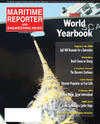
Page 58: of Maritime Reporter Magazine (June 2, 2010)
Read this page in Pdf, Flash or Html5 edition of June 2, 2010 Maritime Reporter Magazine
58 Maritime Reporter & Engineering News
It is our responsibility as engineers to design a better world. Currently, the world is moving toward more environ- mentally friendly, or “green,” technolo- gies with a focus on reducing emissions and finding more efficient sources of en- ergy. Traditional marine diesel propul- sion relies on the combustion of finite sources of energy and is ultimately an in- efficient generator of electrical power and also creates harmful emissions. We have designed an alternate propulsion plant that uses fuel cells instead of engines, and makes excellent use of the boil off gas that naturally occurs aboard liquefied nat- ural gas (LNG) carriers.
The primary objective of our thesis is to design and to evaluate a conceptual propulsion plant for an LNG carrier that uses fuel cells as the propulsive energy source. This includes the selection of an appropriate type of fuel cell and its asso- ciated fuel, and the design and optimiza- tion of the propulsion system and any related systems. Additionally, we have performed a comparison against a mod- ern dual-fuel diesel-electric LNG carrier to evaluate the economic, environmental, and operational feasibility of our design.
There are many reasons to use an LNG carrier for the investigation of the fuel cell propulsion plant. The LNG trade is a profitable venture with expected longevity that is actively investigating al- ternate propulsion methods to reduce shipping costs while reducing negative environmental impacts. Additionally, modern technology has made natural gas acceptable for most fuel cell types be- cause of advances in reformation tech- nology that allow the hydrogen to be extracted immediately before the chemi- cal process. LNG tankers possess a plen- tiful supply of fuel, and are already equipped with time-tested systems capa- ble of dealing with this explosive gas.
Additionally, the boil-off gas (BOG) that is naturally generated onboard an LNG tanker can be used as the main fuel source for the fuel cell system. Loading times in port would be reduced if the ship uses the BOG from the cargo as a main source of fuel, and does not need to spend time loading liquid fuel at a separate lo- cation. We have referenced a 2008 Webb
Institute thesis by Adam Van Doren ex- tensively in our work. He created a methodology for comparing LNG carrier propulsion systems in order to find the most economically efficient case. In his work, he concluded that a dual-fuel diesel-electric (DFDE) system was the most efficient. Thus, we have chosen to compare our fuel cell results to his best- case scenario.
We have used a concept solid-oxide fuel cell system produced by Fuel Cell
Energy Corporation, the DFC-3000, to model our 23 MW propulsion system. A schematic of the internal process in one fuel cell is shown below.
In the simplest case, pure hydrogen gas is provided to the anode, where it is com- bined with the oxygen ions flowing through the electrolyte. This combination yields steam and electrons. The water is ejected from the cell while the electrons migrate through the load circuit to reach the cathode, where they combine with oxygen to create ions capable of passing through the electrolyte and continuing the conversion process. The work done by the movement of the electrons through the load circuit provides the electric power output.
However, it is difficult to obtain pure hydrogen and pure oxygen. Instead, stan- dard air is used to meet the oxygen re- quirements, and a process known as internal reformation is used to extract hy- drogen gas from hydrocarbon fuels. This procedure consists of mixing a hydrocar- bon gas with steam in a high-temperature environment while in the presence of a catalyst.
We propose to use BOG as the main fuel for propelling the ship. The rate of production of BOG is unsteady, and may have to be stimulated at times. Because of this, the gas will be stored in holding 2010 WORLD YEARBOOK FUTURE DESIGN
Alternate Propulsion Plant Using
Fuel Cell Technology
Source: Xianguo Li,
Principles of Fuel
Cells
Figure 2: Carbon Dioxide Emissions Comparison
Since the marine industry continually laments restocking engineering talent to power its future, Maritime Reporter & Engineering News decided to hit the road and find where the future lies. The journey wasn’t far, approximately 45 miles from our office on Long Island at the Webb
Institute. Presented here is the recent work of two Webb upper classmen, Dusty Rybovich and Michael Cariello.

 57
57

 59
59
